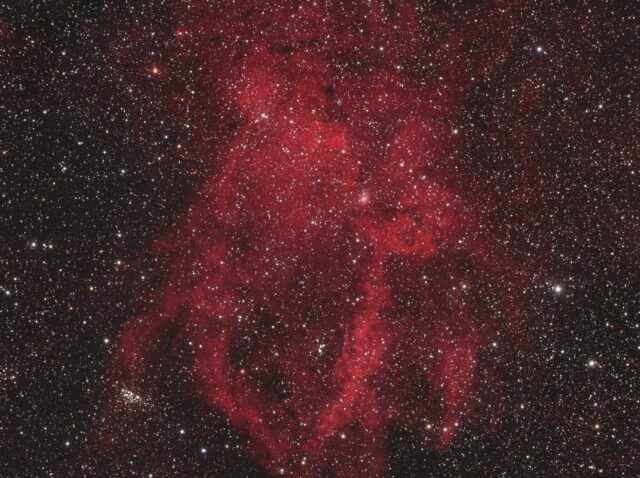The Lobster Claw Nebula
Click image for full size version
November 25, 2021, Cover of the 2023 RASC Observer’s Handbook
 The Lobster Claw Nebula, Sh2-157, lies just northeast of the Bubble Nebula (NGC 7635) in Cassiopeia. This image is composed in tone-mapped (i.e. false) colours made using narrowband sulfur, hydrogen and oxygen filters mapped to red, green and blue, respectively. This palette reveals some of the chemistry of this dynamic region of space and is was made famous by the Hubble Space Telescope. It’s often referred to as the “Hubble Palette.”
The Lobster Claw Nebula, Sh2-157, lies just northeast of the Bubble Nebula (NGC 7635) in Cassiopeia. This image is composed in tone-mapped (i.e. false) colours made using narrowband sulfur, hydrogen and oxygen filters mapped to red, green and blue, respectively. This palette reveals some of the chemistry of this dynamic region of space and is was made famous by the Hubble Space Telescope. It’s often referred to as the “Hubble Palette.”
The image at left was made by blending the brightness from the narrowband image with a natural-colour image produced with a different camera and telescope. I am torn. I love the natural red colour, but the Hubble Palette reveals so much more chemistry and structure with its varied hues.
Tekkies:
Acquisition, focusing, and control of Paramount MX mount with N.I.N.A., TheSkyX and PHD2. Focus with Optec DirectSync motor and controller. Equipment control with PrimaLuce Labs Eagle 4 Pro computer. All pre-processing and processing in PixInsight. Acquired from my SkyShed in Guelph. Average transparency and seeing. Acquired October 28-November 8, 2021 under a partly moonlit sky.
Sky-Watcher Esprit 150 f/7 refractor and QHY600M camera with Optolong H-alpha, O(III) and S(II) 3nm filters
O3: 22 x 20m = 7hr20m
S2: 22 x 20m = 7hr20m189 x 5m
Total: 22hr for narrowband image; 37hr45m for broadband/narrowband blend
Data Reduction and Cleanup
The WeightedBatchPreProcessing script was used to perform calibration, cosmetic correction, weighting, registration and integration of all frames.
Chrominance
Creation and cleanup: The S2, Ha and O3 were combined to make an RGB image. DynamicBackgroundExtraction and BackgroundNeutralization were applied to the image.
Linear Noise Reduction: MultiscaleLinearTransform was used to reduce noise in the RGB image. Layer settings for threshold and strength: Layer 1: 5.0 0.85 Layer 2: 4, 0.75 Layer 3: 3, 0.64 Layer 4: 2.0, 0.2 Layer 5: 1, 0.1.
Stretching: HistogramTransformation was applied to make a pleasing, bright image, with background set to an intensity of approximately 0.10
Luminance
Creation of Synthetic Luminance: ImageIntegration was used to make a noise-weighted average of the three narrowband masters. This was used as synthetic luminance.
Deconvolution: A star mask was made to use as a Local Deringing Support image. A copy of the image was stretched to use as a deconvolution mask. Deconvolution was applied (30 iterations, regularized Richardson-Lucy, Parametric PSF mode).
Linear Noise Reduction: MultiscaleLinearTransform was used to reduce noise in the background areas, using an internal mask to protect bright structures. Layer settings for threshold and strength: Layer 1: 4.0 0.9 Layer 2: 3.0, 0.75 Layer 3: 2.0, 0.6 Layer 4: 0.5, 0.2.
Stretching: HistogramTransformation was applied to make a pleasing, bright image, with background set to an intensity of approximately 0.10.
Combining Luminance and Chrominance
LRGB Combination: The synthetic luminance was applied to the chrominance image using LRGBCombination with default settings.
Additional Processing
Nonlinear Noise Reduction: TGVDenoise was used in L*a*b* mode to reduce noise with a mask used to mainly target the background areas and protect the stars (max. 1000 iterations and convergence selected for both luminance and chrominance).
Contrast Enhancement: LocalHistogramEqualization was applied twice using a mask to select the bright parts of the nebula and protect stars and background. The first pass was with a scale of 50 (max contrast 1.5, strength 0.25, 1 iteration), followed by a scale of 150 (max contrast 1.5, strength 0.27, 1 iteration).
Sharpening: MultiscaleMedianTransform was used to sharpen Layers 2, 3 and 4 with strengths of 0.35 and 0.17 and 0.07, respectively. A mask was used to limit sharpening to high-signal areas and to protect the stars and background regions.
Hue Adjustment: The green tones were transformed towards blue, and yellows towards red, using multiple applications of the CurvesTransformation Hue control. SCNR was applied with a strength of 0.20 through a Green mask generated with the ColorMask script.
Final Steps: Residual magenta was removed by inverting the image, applying SCNR at defualt settings, and reinverting the image. MorphologicalTransformation was applied (morphological selection=0.11; strength =0.5; 3×3 kernel) through a star mask to slightly reduce the stars. Background, nebula and star brightness, contrast, saturation and hue were adjusted in several iterations using CurvesTransformation RGB/K control with masks as required. The DarkStructureEnhance script was applied with a strength of 0.2. ICCProfileTransformation (sRGB IEC61966-2.1; Relative Colorimetric with black point compensation) was applied prior to saving as a jpg.







AWESOME!
Nice
When I began astrophotography many moons ago (no pun intended), I was of the mindset “What is in nature is what I want to see on my camera sensor.” As time has gone by, I no longer subscribe to this ‘mantra’. I appreciate Hubble telescope palette images more so than ever now. They allow us to see structures we cannot in nature. Both images are lovely.